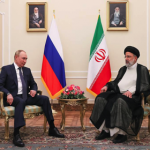On July 19, Russian President Vladimir Putin arrived in Tehran for a tripartite convention[1] with his Iranian and Turkish counterparts to calibrate a new shared strategy on the war-ravaged Syria. Iran’s state media trumpeted the Russian president’s high-security motorcade driving along the streets of Tehran as a source of honor for the Islamic Republic, and pundits close to the establishment talked about a new alliance emerging to countermand the hegemony of the United States.
For Iran’s isolated President Ebrahim Raisi, who has not met any Western leader a year after taking office and never traveled to a European country, a photo with Putin in Tehran could serve as a booster shot, to show how the leader of a powerful nation stood side-by-side with him in defiance of their common enemy, the U.S.
But even before the visit, Iran’s outreach to Russia had been evolving and making headway.
Raisi’s predecessor, the moderate Hassan Rouhani, had spent his eight years in office reframing Iran’s relations with the West. Former US President Donald Trump’s bombshell withdrawal from the Joint Comprehensive Plan of Action[2] boosted the conservatives and hardened anti-West attitudes in Iran. Since then, the momentum for building up ties with Russia as part of a “Look East[3]” policy adopted by Iran, has been gaining steam.
The pro-Russian propulsion of the Islamic Republic has vocal critics, who state that their country has been colonised by its northern neighbour. But it has not induced the government to reassess or reset the direction of the Iran-Russia bilateral. Iran has few options for a diverse coalition of international allies, the outcome of its nuclear obduracy and ideology.
Russia is an alternative for the missing links. It is the only country selling weaponry to an embargoed Iran, even though in scant numbers. Tehran counts on the Russian veto to shield it from opprobrium and punitive action at the UN Security Council. Bilateral business is inconsequential, not enough to accelerate a strategic relationship. In 2021, at its peak, the volume of trade between Iran and Russia amounted[4] to $3.3 billion, and there are plans to elevate this to $40 billion annually by 2025. For now, that seems as much unattainable as Iran’s intention of boosting trade with Turkey to $30 billion a year, a plan that has consistently fallen short of completion by a wide margin.
But there are other dividends from the deepening ties that the leadership in Tehran and Moscow would like to reap. For Russia, Iran’s nuclear program, hamstrung by years of grinding sanctions, is a uniquely fertile ground for sustained investment and profit. Iran spends the most on its nuclear project, and in the absence of competitors willing to work on Tehran’s atomic enterprise, Russia can cash in on this state monopoly. In one instance, the Bushehr nuclear power plant that was[5] to be completed with an investment of $800 million, has cost[6] Iran $11 billion so far, and Russia’s Minatom is its primary shareholder.
As Western energy firms retreated from Iran after the JCPOA was abandoned by Donald Trump, Russia moved to fill the vacuum, tapping into the enormous potential of Iran’s cash-starved petroleum sector in desperate need for capital infusion. In this backdrop, the July announcement of an agreement[7]for cooperation between Iran’s Ministry of Petroleum and Gazprom valued at $40 billion. fits a broader pattern of partnerships that are slated to be long-term and strategic. The amount may seem inflated and may not be realised, given the two countries’ fiscal and technical constraints.
Theoretically, the Russo-Iranian intimacy can boost their mutual resilience against their common adversary and advance their mission of creating an anti-American bastion in Eurasia, in which they are ascendant.
In reality, the still vast size of the US economy and its geopolitical influence holds for now, overshadowing Iran and Russia’s ambitions. But as long as Moscow and Tehran work together and synchronize their strategies, they can ensure that in the aggravated climate after the JCPOA collapse and now the crisis in Ukraine, they are on the same side of the battle.
Kourosh Ziabari is an award-winning Iranian journalist, media correspondent and peace activist.
This article was exclusively written for Gateway House: Indian Council on Global Relations. You can read more exclusive features here.
For interview requests with the author, or for permission to republish, please contact outreach@gatewayhouse.in
© Copyright 2022 Gateway House: Indian Council on Global Relations. All rights reserved. Any unauthorized copying or reproduction is strictly prohibited.
References
[1] The Embassy of the Russian Federation to the United Kingdom of Great Britain and Northern Ireland, “Statement for media following Astana format talks, Tehran, July 19, 2022”, July 20, 2022, https://www.rusemb.org.uk/article/765
[2] European Parliament, “Joint Comprehensive Plan of Action”, July 14, 2015, https://www.europarl.europa.eu/cmsdata/122460/full-text-of-the-iran-nuclear-deal.pdf
[3] James Phillips, “Iran Looks East: Building Ties with China”, The Heritage Foundation, December 21, 2021, https://www.heritage.org/middle-east/report/iran-looks-east-building-ties-china
[4] Mark. N. Katz, “Iran’s new president just met with Vladimir Putin in Russia. What to make of it?”, Atlantic Council, January 24, 2022, https://www.atlanticcouncil.org/blogs/iransource/irans-new-president-just-met-with-vladimir-putin-in-russia-what-to-make-of-it/
[5] Cristina Chuen, “Russian Nuclear Exports to Iran: US Policy Change Needed”, Middlebury Institute of International Studies at Monterey: James Martin Center for Nonproliferation Studies, December 21, 2021, https://nonproliferation.org/russian-nuclear-exports-to-iran-us-policy-change-needed/
[6] Ali Vaez and Karim Sadjadpour, “Iran’s Nuclear Odyssey: Costs and Risks”, Carnegie Endowment for International Peace, April 2, 2013, https://carnegieendowment.org/2013/04/02/iran-s-nuclear-odyssey-costs-and-risks-pub-51346
[7] Nima Khorrami, “Putin’s visit to the Islamic Republic: Bringing Iran closer to Russia while building long-term leverage over Tehran”, Middle East Institute, August 1, 2022, https://www.mei.edu/publications/putins-visit-islamic-republic-bringing-iran-closer-russia-while-building-long-term


